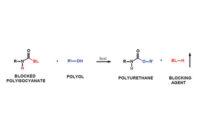Certain polymer-based adhesives are described as crystalline, while others are described as amorphous. How do these adhesive polymer types differ? What advantages could be expected from each type?
Polymers that are described as crystalline have regions in which the polymer segments are aligned or show order, while those described as amorphous lack order. Many polymers contain both crystalline and amorphous regions. The degree of crystallization can vary widely depending on the composition of the polymer and its manufacturing conditions, as well as environmental conditions such as temperature. Crystallinity influences the thermal and mechanical properties of the polymer and ultimately the useful temperature range for the adhesive.
Polymer analytical methods, such as thermal mechanical analysis (TMA) and dynamic mechanical analysis (DMA), are used to quantify the thermal properties of a polymer, including the degree of crystallization. The glass transition temperature (Tg) and crystalline melting temperature (Tg) are key values that describe polymer properties.
In broad terms, crystalline polymers are linear and synthesized with raw materials of a simple, regular structure. Hexanediol adipate is an example of a linear polyester polyol used to prepare polyurethane polymers with a crystalline backbone. Both hexanediol and adipic acid are linear symmetrical raw materials. Polyesters of this type are solids at room temperature.
The degree of crystallization is reduced if one of the raw materials of the polyester contains a side group. An example of this type of structure is neopentyl glycol. Neopentyl glycol adipate is a liquid. Crystalline and amorphous polyols can be blended to produce an intermediate level of crystallinity, or a mixture of glycols could be employed to synthesize the polyester polyol. An amorphous polymer also results if the polyol component is a polyether polyol, such as polypropylene glycol.
The isocyanate choice also strongly influences the crystalline/amorphous balance. A crystalline polyurethane polymer will result from reacting hexanediol adipate with a linear symmetrical isocyanate, such as the 4,4’-isomer of diphenylmethane diisocyanate or hexamethylene diisocyanate. A polymer with a reduced crystalline character is produced by using a diphenyl methane diisocyanate that contains a mixture of the 4,4’- and 2,4’-isomers. The level of crystallinity would also be reduced if the isocyanate contains polymeric MDI.
The optimum balance of amorphous/crystalline character depends on the specific requirements of the adhesive application. Crystalline polymers are known for rapid generation of initial bond strength. For a moisture-curing reactive hot adhesive, fast strength development would result from a hexanediol adipate/4.4’-MDI prepolymer. In addition, the strength development increases as the molecular weight of the starting polyester increases. A formulation based on hexanediol adipate with a hydroxyl number of 10 (5,600 equivalent weight) will crystallize faster than the same polyester with a hydroxyl number of 112 (500 equivalent weight).
The desire for rapid strength development must be balanced with the need for a sufficient open time to apply the adhesive and join the parts together in the final assembly. This could be a significant issue for a large or structurally complicated application. Extended open time could be achieved by using an isocyanate that contains 2,4’-MDI or an amorphous polyester.
Crystallinity also has a strong influence on the high-molecular-weight polymers present in polyurethane dispersions. A dispersion based on an amorphous polyol such as polyether will often show room temperature tack and will readily bond two substrates at that temperature. This contrasts with a dispersion based on hexane or butanediol adipate, which will have a melt temperature higher than room temperature; effective bonding will only be possible if the polymer is heated above the Tm. At this higher temperature, the polymer shows tack and will be ready for bonding.
Any views or opinions expressed in this column are those of the author and do not represent those of ASI, its staff, Editorial Advisory Board or BNP Media.



